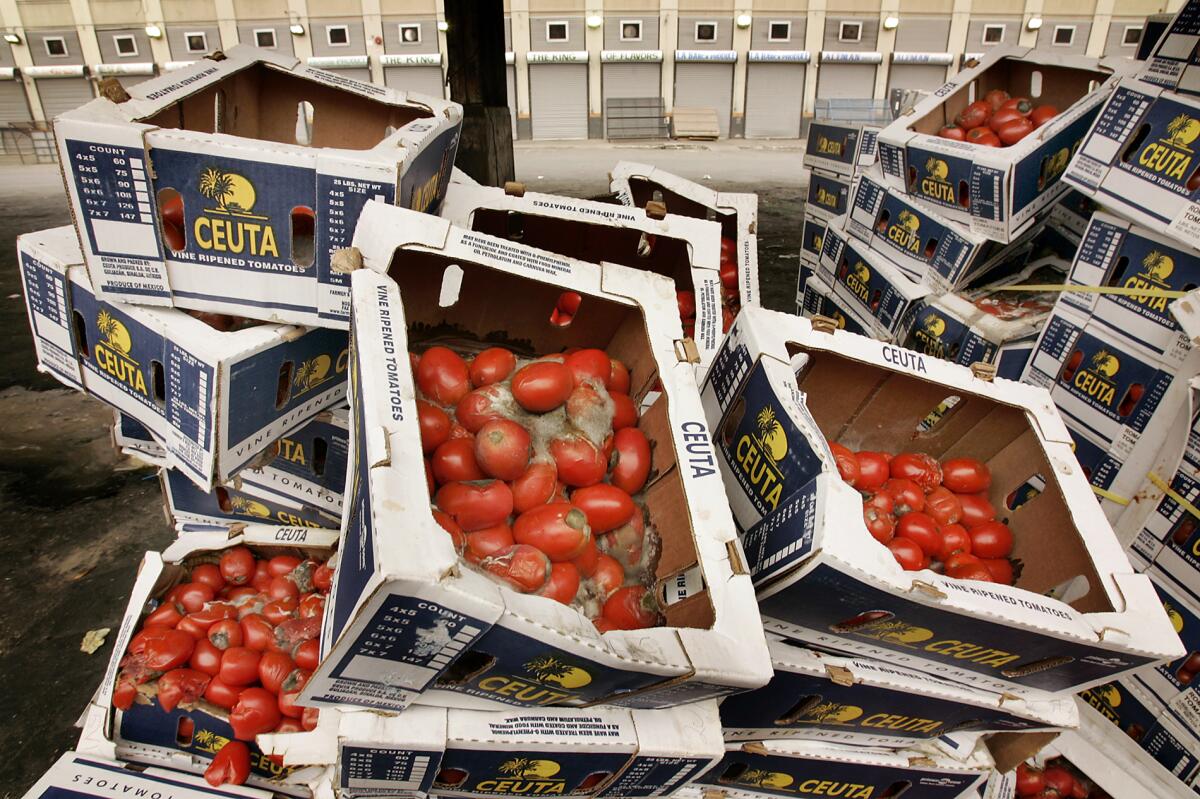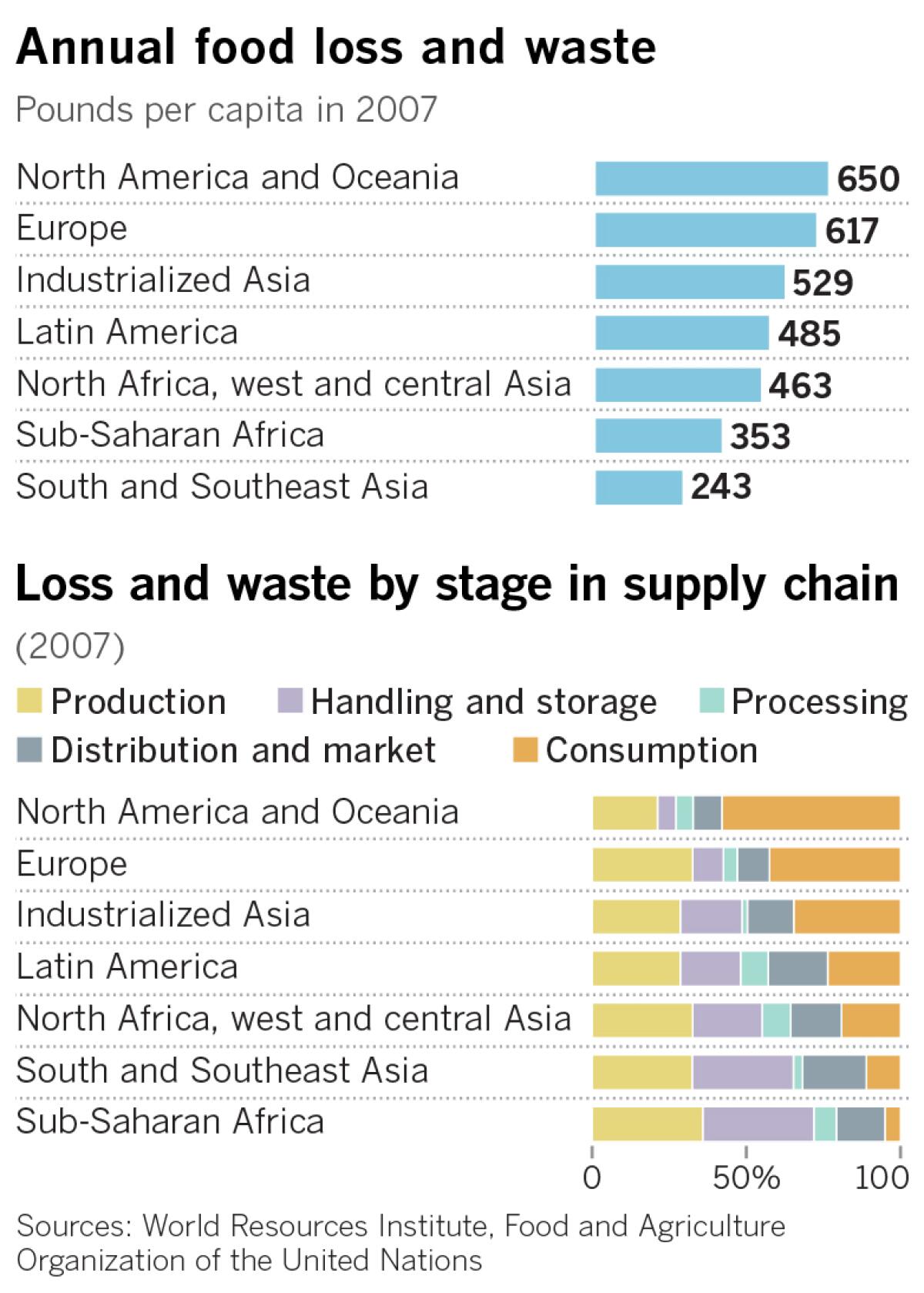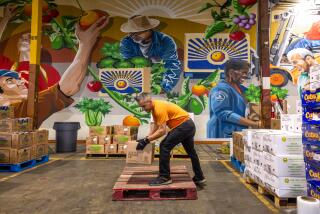1.3 billion tons of food being wasted each year. Can we stop it?

Across the planet, more than a billion tons of essential, nutritious, life-sustaining food goes to waste each year.
It is being eaten by weevils in sub-Saharan Africa and inadvertently passed over by harvesters in the rice fields of Southeast Asia. It gets scraped into the trash in restaurants in North America, and sometimes left to rot on the vine on farms in Europe. In today’s economy, it can be cheaper for farmers to leave perfectly good food in the fields than to sell it.
Roughly one-third of all food produced on Earth is either wasted or lost somewhere along the way from the farm to our bellies, according to a 2011 report from the United Nations’ Food and Agricultural Organization. That translates to about 1.3 billion metric tons of food loss per year.
And if that proportion doesn’t change, the amount of wasted food will balloon to 2.1 billion tons per year by 2030, experts say.
All this wasted food isn’t just an ethical problem — it’s an environmental problem as well.
Agriculture accounts for at least 8.4% of total greenhouse gas emissions across the globe, according to the U.N. (Meat, dairy and rice production are the biggest offenders.) Currently, emissions associated with food that is lost or wasted adds up to about 4.4 gigatons of greenhouse gasses per year. That means that if uneaten food were its own country, it would be the third-largest greenhouse gas emitter in the world, just after China and the U.S.
To tackle this issue, members of the U.N. adopted a planet-wide goal of reducing food waste by 50% by the year 2030. Exactly how to accomplish that goal, however, was not part of the conversation.
But now researchers have a global action plan.
In a report published this week by the World Resources Institute, a team of experts who study food loss and waste lay out a strategy that they say could accomplish the U.N.’s ambitious goal. All it will take is for just about everyone — from farmers to eaters — to change what they’re doing now.
“The problem is dispersed across so many actors, and we all play a role,” said Craig Hanson, who studies sustainable food systems at WRI, a global research institution. “Everyone has to do their part and follow through. It’s got to be a full-chain kind of approach.”

The percentage of food lost and wasted is ultimately pretty similar across different regions of the globe, according to the U.N.’s Food and Agricultural Organization. In North America, about 35% of total food produced never gets consumed by humans, along with 36% in sub-Saharan Africa and 34% in Europe, South America and industrialized Asia. South and Southeast Asia are the outliers, with just 26% of the region’s total food going to waste.
What does differ wildly between regions is the amount of food lost per capita, WRI analysts determined. In North America, for example, 650 pounds of food are lost or wasted for every man, woman and child each year. That’s more than twice as much as in South and Southeast Asia, where it’s a comparatively small 243 pounds wasted per person per year.
Another source of disparity was where along the chain that food gets lost. In North America, 58% of total food loss occurs at the consumption stage and 6% is lost during storage and handling. In sub-Saharan Africa, just 6% of total food loss occurs at the consumption phase, but 36% is lost during storage and handling, FAO data show.
That means no single intervention will work for every region on the planet.
Improving access to solar-powered cold storage facilities and airtight grain storage bags could radically reduce the amount of food lost in developing nations. In wealthier countries, however, consumers will need to be persuaded to buy more fruits and vegetables that look “imperfect” but are totally fine to eat. It would also help for manufacturers to replace “sell by” labels with ones that say “use by.”

Instead of a one-size-fits-all solution to solving the food lost and waste crisis, the new report proposes a simple three-step system that they say can be implemented across the planet. They call it “Target-Measure-Act.”
The first part of this strategy is to establish clear goals. The report’s authors know this is doable because it has already occurred in countries that are home to about half of the world’s population, including Australia, Japan, Norway, the Arab Emirates, Vietnam, China, and members of the European and African unions. In addition, food retailers and manufacturers in the U.S. and elsewhere — including Kroger, Walmart, Wegmans, Kellogg Co. and PepsiCo — have made commitments to halve food loss and waste in their own operations by 2030.
It’s a decent start. But more countries will have to set their own goals around food loss and waste if the U.N.’s target will be reached by 2030.
“Ideally within a couple of years, 90% or more of the world will live in a country with an explicit food loss waste reduction target,” Hanson said.
To know how well the world is progressing toward that goal, governments and industries need to have better data on how much food is being wasted now and where in the food chain it is disappearing. This will allow policymakers to identify what the authors call “hot spots” and target those points directly.
Many countries have already taken steps to improve their measurements of lost and wasted food over the last two decades.
The United Kingdom has been a global leader, producing countrywide estimates of food waste for 2007, 2010, 2014, 2015 and 2018. The U.S. has been estimating food loss and waste both per capita and in absolute amounts since 2015. Japan has been collecting post-farm food loss and waste data since 2001. Other countries are getting on board as well, including Kenya, Saudi Arabia, Spain, New Zealand, Zambia and Argentina.
Ultimately, however, the goal of reducing lost and wasted food across the globe can be achieved only with concrete action, the report authors say.
This might look like the pay-as-you-throw policy implemented in South Korea in 2013 that requires residents of Seoul to pay for the food they waste by weight.
It might look like North American farmers allowing nonprofit organizations to collect unharvested crops that can’t be sold and redistributing them to food pantries and soup kitchens.
It might also look like catering companies keeping better track of what foods are most likely to be left over and making less of them next time.

Not everyone who studies food loss and waste is optimistic that the world will meet the 2030 target.
“Many governments and businesses are giving more lip service to the topic of reducing food loss and waste than taking concrete action,” said Martin Gooch, chief executive of Value Chain Management International, who works on food waste issues.
But the report’s authors said they remained hopeful.
“Almost all the knowledge, technologies and practices exist to address to meet the goal,” said contributor Dirk Maier, who studies post-harvest engineering at Iowa State University. “What will influence whether it is accomplished is partly political will, and the commitment by our economic supply chains to make things work more effectively and efficiently.”







